The advent of self-driving cars represents a significant leap in innovation, poised to fundamentally alter our relationship with car ownership. As technology evolves, it compels us to re-evaluate traditional car ownership models, highlighting both opportunities and challenges.
The Shift Towards Autonomous Vehicles
Self-driving cars are at the forefront of automotive innovation, indicating a transition in user behavior and societal norms. With the increasing development of autonomous vehicle technology, individuals may find less necessity to own a car. Instead, they may prefer a more sustainable model of mobility, where car-sharing and ride-hailing services become the norm. This shift reflects a mindset that emphasizes access over ownership, reducing costs associated with maintenance, insurance, and vehicle depreciation. Moreover, the convenience of on-demand transport from advanced autonomous fleets will be appealing to urban dwellers who prioritize efficiency over asset ownership.
Redefining Car Ownership Models
As autonomous cars gain traction, traditional car ownership models will inevitably be redefined. The proliferation of self-driving technology could lead to a surge in subscription and leasing models that provide users with flexible access to vehicles without the burdens of ownership. Consumers may lean towards services that offer a range of vehicles suited to their needs, from sedans to SUVs, available on demand. This approach reduces the capital tied up in purchasing a car and supports a shift toward a more sustainable approach to transportation, ultimately leading to happier, more satisfied consumers.
The Impact on Urban Planning
The rise of self-driving cars will have significant implications for urban planning and infrastructure. Cities might need to adapt to accommodate the needs of autonomous vehicles, including dedicated lanes for self-driving cars and augmented traffic management systems. Moreover, parking spaces could be repurposed or removed entirely, with self-driving cars capable of finding parking spots or returning to a fleet hub autonomously. As a result, urban centers may become more pedestrian-friendly, leading to vibrant public spaces and improved overall quality of life. This transition highlights the necessity for planners and policymakers to leverage innovative transportation technology effectively.
Environmental Influence of Autonomous Vehicles
The environmental impact of self-driving vehicles is another vital consideration. With the potential to optimize driving behaviors and minimize traffic congestions, autonomous cars may significantly reduce greenhouse gas emissions. Additionally, as electric self-driving vehicles become more common, their adoption could lead to a decrease in fossil fuel dependency, aligning with global sustainability goals. This change can encourage cities to pursue greener initiatives while contributing to national and international climate targets, resulting in cleaner air and healthier urban living environments.
Changing Consumer Preferences
Consumer preferences are shifting in response to the innovations offered by self-driving cars. Younger generations, in particular, place greater value on flexibility and sustainability rather than traditional notions of car ownership. Brands that adapt to these emerging preferences will find new opportunities in the marketplace. Companies that offer enhanced experiences through connectivity, on-demand services, and seamless integration with technology will likely attract a loyal customer base. As awareness of benefits grows, the demand for autonomous transportation options will continue to rise.
The Future of Transportation
The future of transportation lies in a balance between human-driven and autonomous vehicles. While self-driving technology offers numerous advantages, like increased safety and efficiency, there will still be scenarios where human drivers are necessary. A hybrid approach, where both autonomous and traditional vehicles coexist, will likely define the landscape moving forward. The evolution of this relationship between vehicles showcases the innovative spirit that drives the automotive industry, ultimately enhancing transportation while addressing modern challenges related to ownership and accessibility.
Disclaimer: The content provided in this article is for informational purposes only and does not constitute professional advice.





















